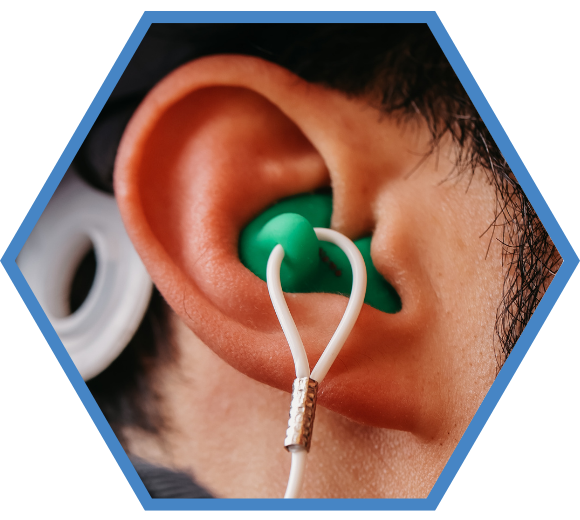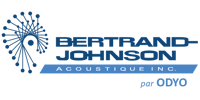CUSTOM EARPLUGS
Fit-Test
Best practice for your hearing protection

By Hany Ghonaim | Founder at ODYO
In noisy working environments, hearing protection plays an essential role in preventing occupational deafness. However, simply wearing hearing protectors does not guarantee optimum protection, and so "fit-testing " becomes essential to ensure that the protectors are fulfilling their role effectively.
What is a hearing protector fit test?
Fit testing systems are used to evaluate the actual effectiveness of hearing protectors used by workers. Because each individual has a unique anatomy, hearing protectors do not offer the same noise reduction to all users. So, unlike traditional methods which calculate an average attenuation for a group of people evaluated in a laboratory, Fit-Test assigns a personalized attenuation score for each individual. This result is a tailor-made measure, reflecting the actual attenuation achieved by the worker in his or her working environment. The calculated personal attenuation rating can then be subtracted directly from the noise exposure in decibels (dBA) to determine the residual noise exposure or attenuated noise level after wearing hearing protection. In other words, this process ensures that the hearing protection worn is correctly fitted and provides the desired noise reduction in decibels.
Benefits of hearing protection fit testing
Fit testing plays an important role in the effective management of hearing protection in noisy work environments. Fit-Tests help to :
-
Facilitate selection of the appropriate hearing protector: Thanks to customized tests, workers can choose a protector tailored to their individual needs and the specific requirements of their working environment. This helps maximize the comfort and effectiveness of protection.
-
Improve hearing protector fit: By providing immediate feedback on fit, these systems help users position their equipment correctly, reducing the risk of poor sealing or inadequate protection.
-
Train users for consistent fit: Fit testing also provides a learning opportunity, enabling workers to understand good practice in adjusting their equipment repeatedly and consistently. This consistency is essential to ensure reliable protection on a daily basis.
-
Periodically check fit effectiveness: The systems enable regular checks to be made to ensure that hearing protectors remain effective over time, even in the face of changes such as equipment wear or anatomical variations in the user.
-
Evaluate noise exposure levels with protection: By combining the results of fit tests with noise exposure data, it becomes possible to accurately estimate the actual noise level perceived by the worker. This estimate is essential for evaluating the effectiveness of noise reduction strategies and adjusting preventive measures where necessary.
Challenges of adding Fit-Test to your prevention program
Despite their many advantages, fit testing presents certain challenges that are important to consider when integrating them into a hearing loss prevention program:
-
Commercially available equipment focuses mainly on earplugs due to their higher attenuation variability, unlike earmuffs, which are easier to fit.
-
Fit tests offer an immediate assessment of potential hearing protection, but do not always reflect actual use over a long period. They show what a user can achieve under guidance, but not necessarily consistently on a daily basis.
-
Integrating fit-testing systems can increase costs and require more time for individual testing.
- Fit testing systems all aim to assess the effectiveness of hearing protection, but use different technologies, making the results not always comparable.
Mitigating challenges
While fit testing is a powerful tool for evaluating the effectiveness of hearing protectors, the challenges it poses can be mitigated by targeted strategies:
-
Incorporating protocols for all types of hearing protectors, including earmuffs, ensures comprehensive protection in addition to requiring employee education on proper fit.
-
Regular follow-ups and annual reassessments, complemented by ongoing training, improve employee compliance and align tested performance with actual use.
-
To reduce costs and time, testing can be concentrated on high-risk employees or new arrivals, and modular solutions can be integrated into existing training courses to maximize effectiveness.
-
The use of recognized test standards, such as ANSI, makes it easier to compare results between technologies. Moreover, adopting a single, uniform method for assessing performance remains an option.
By adopting these approaches , Fit-Tests can become a key and sustainable component of hearing loss prevention programs, while minimizing the obstacles associated with their implementation.
Recognized standards and guidelines
Since 2008, organizations such as OSHA, NIOSH and NHCA have recognized fit testing as a best practice. According to a joint publication, "Studies show that when individuals participate in the fitting process and receive positive feedback, they are more likely to use their hearing protectors correctly," thus helping to reduce noise-induced hearing loss in the workplace.
For its part, ANSI/ASA S12.71-2018 helps standardize criteria and methods to ensure greater reliability of available fit testing systems.
ANSI/ASA S12.71-2018 (R2022)
This standard establishes performance criteria for fit testing systems, ensuring greater accuracy and transparency of results.
-
Development of conformities so that manufacturers can adapt their products to meet the requirements of the standard.
-
Harmonization of systems to standardize results and enhance comparability.
CSA Z94.2-14 (R2024)
This standard emphasizes the importance of fit testing to :
-
Meet individual needs and provide a personalized estimate of the hearing protection actually obtained.
-
Calculate the Personal Loss Index (PLI), which is a personalized measure comparable to the Noise Reduction Index (NRI).
- Train users on how to wear and correctly fit hearing protectors in their ears.
Fit-Test: Best practice in hearing protection
Fit testing plays a key role in detecting ill-fitting or inadequate protectors, which improves workers' confidence in their protectors. In addition, they close the gap often observed between actual noise reductions and those indicated by manufacturers, guaranteeing more effective protection.
Although the RROHS does not require employers in the province of Quebec to "Fit-Test" hearing protectors, standards and best practices in the field are tending to integrate this step further into hearing loss prevention programs.
By integrating Fit-Testing into your hearing protection program, you can ensure compliance with regulatory requirements, reinforce hearing protection adherence within your organization, and reduce the risk of hearing loss in the long term.
So, what are you waiting for? Even Alberta has already jumped on the bandwagon of mandatory fit testing!
Frequently asked questions
Fit-Test
Answer

Reduce noise exposure with customized earplugs
Reinforce your prevention program with our custom-made earplugsthat offer optimum comfort and superior protection to prevent occupational deafness.

-1.png?width=144&height=72&name=BJA%20_%20Logo%20Color%20%20(1)-1.png)
